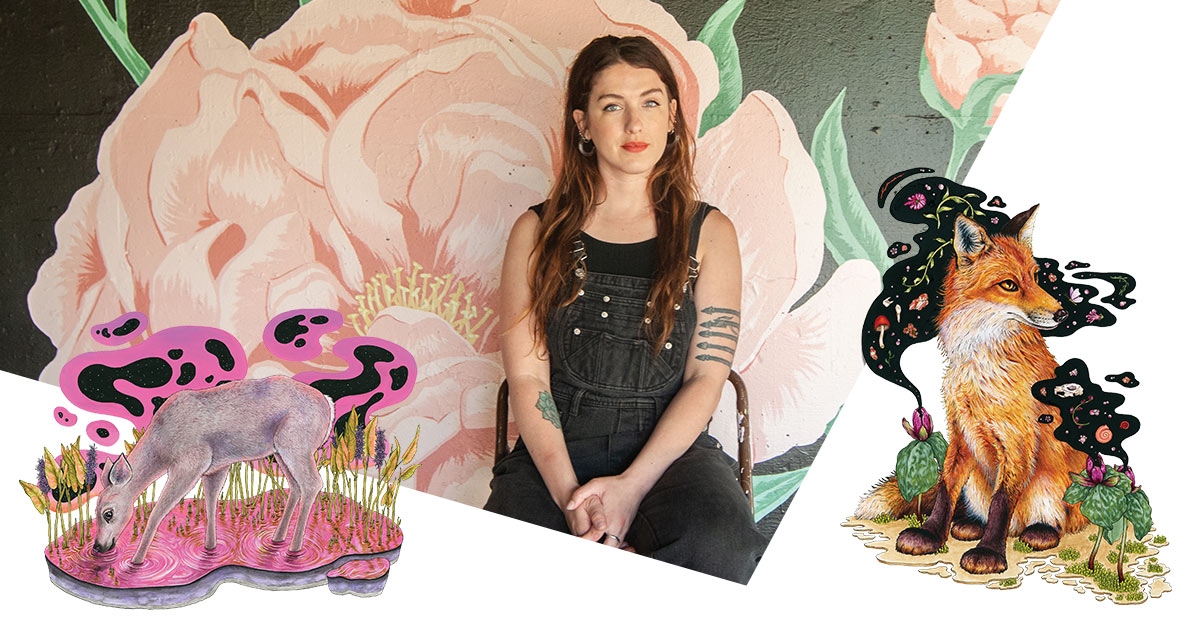Emily Luyk is an adventurer. After growing up in Byron Center, she moved to San Francisco at 19, spending two years there before moving to Grand Rapids. She studied Illustration at Kendall College of Art & Design, earning her BFA in 2017. Since then, she’s had shows and exhibitions in Chicago, Tennessee, and Florida.
Her illustrative work is well-observed and often charming; in one piece, titled “Blossom Possum,” flowers seem to be growing out of the titular creature. “Isolation,” which features a nude woman with a house for a head, goes further afield.
Her website offers various items, including custom pet portraits. To come is jewelry; together with her partner Collin, she’s begun work in metalsmithing.
When did you realize you were good at this stuff? Were you drawing as a child? As a teenager?
It’s hard to say, but I always knew that I loved it. As soon as I learned how to draw, that’s what I wanted to do. In kindergarten, when they asked what we wanted to be, I wrote down that I wanted to be an artist. Something just felt right about it.
I tried sports but realized that wasn’t for me. I was involved in theater, musicals, that kind of thing. I just knew that I wanted to be involved in the arts as much as possible. On the weekends, my friend group and I would do things related to art. It’s how we spent our time.
Your illustrative work reminds me of the books I read in childhood. Were illustrated books important to you growing up?
They really were. I’m not sure I made that connection when I was little, but I loved reading. Many illustrations have stuck in my mind. I loved the little hidden things you’d find in Mercer Meyer books. He’d had an animal on almost every page, tiny animals hidden in the scenes.
Or books with borders around every page, and little pictures in the borders. That had an impact on me, for sure. Even now, I like hiding little details in there.
One of the hallmarks of your work is a strong attention to detail. Your animals are charming, but they also feel very real. How important is getting things right to you?
I think a huge part of that was going to college for this, because Kendall’s illustration department was really big on realism. We’d work from photos, all that. It’s not that I want to do photorealism, exactly, but I do want to be able to create something that looks pretty real. But there’s some surrealism there, too. The fact that aspects of it look realistic adds to the dreaminess. That’s really how I ended up finding my style.
There’s a quality of whimsy, or maybe inventiveness is a better word, in some of your work. Was that something you were always comfortable with?
I was always really drawn to imagination. I was pretty far behind my siblings, age-wise. I played alone a lot, was always outside imagining things. What if I crawl into this fort in the woods and enter another world? A lot of that stuck with me as an adult.
I like to go hiking and feel the connection to what else is out there.
“Isolation,” with its image of the human figure whose head is a house, speaks to the loneliness that seems to have increased in the last few years. What was the inspiration for that piece?
That one happened during COVID, when a lot of us were alone quite a bit. I don’t know that I necessarily tried to make it about that, but I was home a lot. I’d listen to illustration podcasts and think about all these ideas I had. I’d done so many nature things; I wanted to explore new subject matter, not get stuck in a rut. I think the drawing represents that.
You’ve made some really striking murals. What’s the process for those like? How much input does the person or business commissioning them have?
It depends on the project. My first mural, I designed it myself and sent in the proposal. I had total control over that—well, besides picking the wall. But even the Starbucks project I did afterward: obviously, their hands were in that a little more, but they still gave me a surprising amount of freedom. I’ve never had anyone control those projects completely, which has been nice. They trust the artist.
You retweeted a quote from Ludwig Bemelmans, who said, “My greatest inspiration is a low bank balance.” How do you balance art and commerce?
There’s a very long road of growing the business when you work for yourself in an industry that’s not...it’s not always the priority for people, especially if they don’t have much extra money. It can be rough at times. It comes and goes in waves. But it’s gotten better as I’ve gotten better.
Could you talk a bit about your customer pet portraits?
Most of the time, it’s a memorial. Someone wants it to honor their pet who’s passed on, or a friend of theirs does, or a family member. I’ve done cats and dogs. I’d love to do lizards and birds, too. It’s kind of a nice thing to do for people, it means a lot.
They’ll tell me something about their pet or about themselves, and if they have any particular way they’d like to tie things in. I run with it and get to surprise them with something. It’s pretty fulfilling.
Where do you see your art going from here?
What I hope to happen is I can make it make enough and be known well-enough that the road gets a little smoother. There are these galleries I really love, where I never would have dreamed of getting into. But now my goal is to get there.
To see more of Luyk’s work, visit emilyluyk.com or @emilyluyk.





